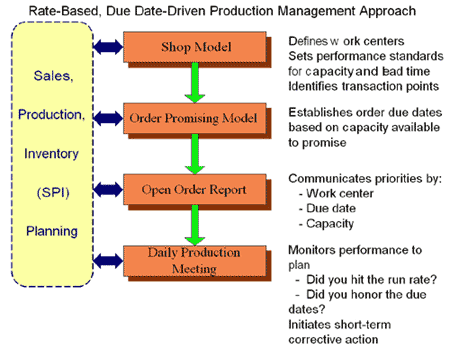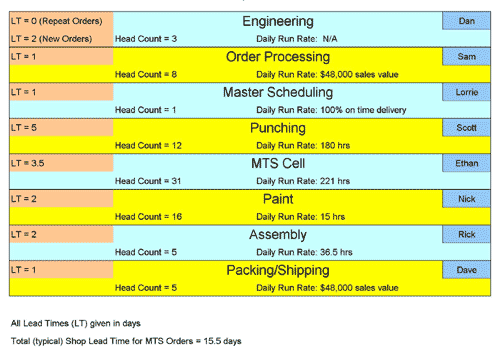Home
> About Us > News
and Articles > Making World Class/Lean Manufacturing Work
MAKING WORLD CLASS/LEAN MANUFACTURING
WORK By Mark A. Hoffman
Introduction
An Approach with
Advantages
Enhancing Other
World Class/Lean Manufacturing
Principles
Typical Results
Introduction
In TCA’s efforts to implement World Class/Lean Manufacturing
with our clients, we’ve learned how Production Management
significantly contributes to success.
This process for managing the flow of work through production is
straightforward and beneficial—yet it calls for:
- • Commitment to adopting new tools
• Open, clear communication
• Accountability

An Approach With Advantages
The objective of Production Management is to provide the right level
of information and support for:
- • Top management in maximizing production capabilities
for customers
- • Schedulers in understanding production capabilities,
then making promises (taking orders and setting due dates) based
on the ability to deliver on those promises
- • Supervisors and team leaders in executing the company’s
promises by performing to capacity and solving the inevitable
problems

Enterprise Resource Planning (ERP) systems can organize
manufacturing data (bill of materials, routings, etc.) but they
do a poor job of tracking manufacturing capacity and monitoring
performance. Cooperative, team-based tools are needed—such
as the rate-based, due date-driven production management approach
illustrated on page 1 and described below.
Shop Model
The Shop Model lays the groundwork for the entire Production Management
process. Its purpose is to gather and organize the production environment
information needed to plan the flow of work.
Details in the Shop Model include the track an order
takes from the time it’s received to the time the product
ships. It also shows relevant information about lead times, daily
run rates, performance, and accountability for all work centers,
shared resource areas, and front office activities.
Although the Shop Model only needs to be created
once, it must be updated when routings, capacities, resources, and
lead times change.
Order Promising Model
This discipline gives schedulers an indication of when the next
order can be promised and helps ensure production can deliver. Without
it, orders can be late before they’re even taken.
The Order Promising Model graphically presents the
workload scheduled to a specific work center or shared resource.
It also shows capacity available to complete additional work, using
the daily run rate from the Shop Model. (Based on available capacity,
the promise date could be different for any given order.)
When due dates are based on the Order Promising Model, you’re
making the clear statement that orders will be delivered on time
if each work center completes work at the SPI daily run rate, within
the Shop Model’s planned lead times.
Open Order Report
Together, the Shop Model and Order Promising Model create the plan
supervisors and team leaders can use to manage production. That
plan is communicated in the Open Order Report. Each work center
receives a daily Open Order Report that lists work in due date order.
Each day, work centers complete the topmost work orders
on the Open Order Report until the total amount of work done equals
their daily run rate. A work center may look 1-3 days forward in
the schedule to group work and to minimize setups or to operate
more efficiently in some other way.
The Open Order Report often can be created with only
simple modification to an existing dispatch report.

Daily Production Meeting
The heart of the Production Management process is the Daily Production
Meeting. If every work center completes the orders on their Open
Order Report and experiences no hitches, all work will be completed
on schedule and all deliveries will be made as promised. However,
in production there are always hitches.
At the Daily Production Meeting—the mechanism for reporting
performance, handling feedback, and dealing with hitches—each
team leader reports on work center performance for the previous
day. This 15-20 minute meeting brings together all the accountable
people (listed on the Shop Model) and gets their individual answers
to these fundamental questions:l
- • Have you honored all due dates?
• Have you hit your daily run rate?
• Are there any quality issues?
• Are there any safety issues?
• Are there any operational issues (such as plant tours
or scheduled maintenance)?
• Are there any reschedules?

Enhancing Other World
Class/ Lean Manufacturing Principles
As a company implements a Production Management process, related
principles become very important. For example:
- • Shop Layout. Cellular layouts reduce overall
lead times and handling between work centers
• Setup Reduction. Decreasing setup times creates
additional capacity and scheduling flexibility
• Smaller Lot Sizes. Running smaller lots more
frequently also creates effective capacity and increases flexibility.
Smaller lot sizes often accompany reduced setups.
• 5S Housekeeping. Housekeeping enhances the movement
of material, people, and information.
• Pull Systems. Pull systems can improve throughput and
reduce shop lead times. They also can replace the Open Order Report
as a means of scheduling a work center.

Typical Results
Companies can gain significant results by implementing good Production
Management practices in conjunction with World Class/Lean Manufacturing
principles.
As an example, here’s what a sheet metal job shop achieved
over a recent 18-month project:
Sales increased by 58%
Productivity (sales/direct labor employee) went up 90%
On-time deliveries rose from 88% to 99.5%
Order lead time decreased from 5 weeks to 4 weeks
By understanding the shop environment and developing a handful of
tools, you can support the efforts of schedulers, supervisors, and
team leaders in effectively managing the production floor. TCA consistently
sees profound improvements in several areasd—from workflow
and communications to productivity. And, as with all continuous
improvement activities, doing them well makes coming to work much
more enjoyable for all!

Contact Us for a Free Assessment!
|



